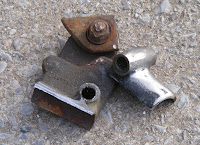Normally, I arrive at Saturday, and if I haven't managed to do anything to the BMW, I'll do something to it.
I did make a start on the exhaust system in the course of the week, and at least have a clear idea of how to achieve what I want now. The other thing that became apparent was that the workshop badly needed tidying.
Having abandoned exhaust building to sort out the exhaust building environment, meant that Saturday arrived with no real progress made. As I had to fix Mrs.Bridges' car, and had made arrangements for Mr.Lawless and I to go and talk to a man about his turbo charged Harley Davidson, Saturday came and went with no tangible progress made either.
On the intangible front, I had the vague idea that I wanted the exhaust to look similar to the exhaust on the Team Incomplete Boxer, but have built enough exhausts in my time to realise that since I have down tubes on my frame and don't have a deep sump on my engine, similar didn't mean identical.
I got as far as bending up a tube to check that the radius of the former I have for 1 1/2" tube would work and to remind myself of what is and isn't possible with that particular former. If you're not familiar with BMW engines, the right side cylinder is set further forward than the left side one.
I should be able to bend the pipes so that they come out of the head and bend around to the front of the frame where the drop down to form a shallow "V". Where they meet, I'll bend them so that they'll point out of the right side of the bike again, with those bends concentric, and the left side pipe behind the right side one, but pointing up in the air slightly. That should let me bend them through 90 degrees so that they both point back along the motorcycle, with the left side pipe running directly above the right side one.
After the pipes turn to run along the frame they ought to be close to equal length, so I might as well look up the relevant information in the manual and use the calculator here to position the collector. After that, I'll use some 1 3/4" for the tail pipe and and bend that to turn across the back of the engine and exit on the right pointing up in the air for the silencer.
I'd like to do each side's pipe in one piece of tube, but that may not be possible. I'll find out in the week with a little luck.








